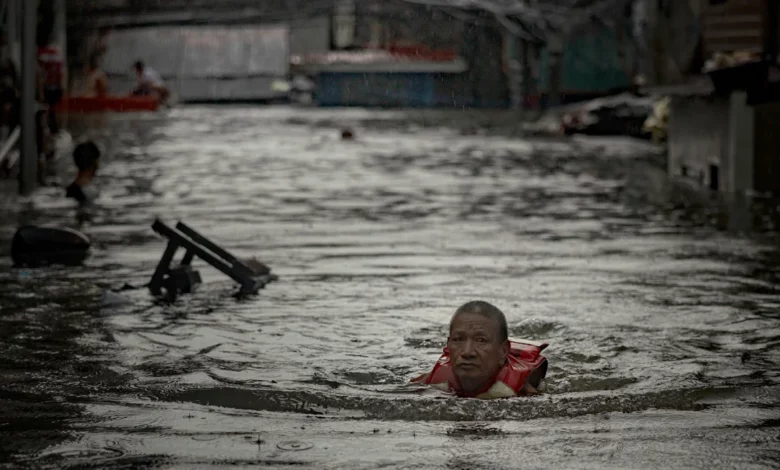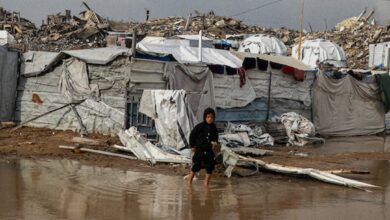
Much of the Philippine capital remained underwater Thursday after deadly Typhoon Gaemi worsened torrential monsoon rains that lashed the country, trapping thousands of people in rising flood waters and causing widespread damage.
Continuous heavy rains, massive flooding and landslides across the Philippines killed at least 13 people and displaced more than 600,000, Philippine authorities said during a disaster relief briefing Thursday.
Unlike in Taiwan, the typhoon – known locally as Carina – didn’t make landfall in the Philippines, but its powerful outer bands dumped more than 300 mm (12 inches) of rain in the Manila region and parts of the main island Luzon, prompting officials to declare a “state of calamity” in the capital on Wednesday and evacuate tens of thousands of people.
Video and images from Manila show people wading through chest-deep water and some clinging precariously to overhead power lines as major roads turned into rivers. Families with children wrapped in towels or plastic ponchos huddled together on dinghies as disaster response teams rescued them from flooded houses.
Some parts of Metro Manila – home to 13 million people – have reported floods as high as one-story buildings, with some residents spotted waiting for rescue on roofs, according to the official Philippine News Agency.
The southwest monsoon, supercharged by the typhoon, is still causing misery and destruction in the Philippines even after Gaemi moved north and made landfall in Taiwan early Thursday as the equivalent of a Category 3 major hurricane in the Atlantic.

Heavy rainfall, gusty winds and a dangerous storm surge killed at least two people and injured nearly 300 others in Taiwan’s northeast, according to the Central Emergency Operations Center.
Taiwan remained largely shut down for a second day Thursday with flights canceled and financial markets, schools and offices closed as heavy rainfall continued to pummel the island. Some mountainous regions have reported up to 1,219 mm (48 inches) of rain.
A cargo ship carrying nine crew members sank off Taiwan’s coast in rough seas on Thursday, according to Taiwan’s National Fire Agency. The Tanzanian registered vessel sank around 20 miles off the coast of the southern port city of Kaohsiung and was not equipped with a lifeboat.
All nine crew members “fell into the sea and were floating there” wearing life jackets, Hsiao Huan-chang, the head of the National Fire Agency, said in a press conference.
The island is expected to endure several more hours of torrential rain even as the typhoon’s center moved into the Taiwan Strait Thursday and headed toward China.
The storm is expected to make landfall in China’s southeast coastal Fujian province, bringing more strong winds and downpours to a country already hit hard by weeks of extreme rain and deadly flooding.

Philippines disaster
The Philippine Coast Guard (PCG) on Thursday said it was responding to a maritime incident involving an oil tanker that capsized off the coast of Bataan, west of Manila. PCG spokesperson, CG Rear Admiral Armando Balilo said 16 of the 17 crew on board had been rescued and search teams were continuing to look for the missing crewmember.
Images show the coast guard launching a rescue operation and the ship almost fully submerged in rough seas.
On land, the flooding has caused widespread disruption that forced authorities to close schools, businesses and cancel more than 150 flights on Thursday.
Rescue services said Thursday they are continuing to pull trapped residents out of flooded buildings. Some homes could be seen completely inundated and vehicles submerged on flooded streets.
Quezon City, north of Manila, was hit hard by the floods. The city government said in a post on X that more than 55,000 people, including nearly 16,000 families, had been evacuated and were sheltering in evacuation centers.
The Philippine Red Cross has launched an emergency appeal for donations to help the thousands of Filipinos affected by the typhoon-enhanced monsoon.
“Families and children are without water, electricity and basic services, whole others are stranded in knee- and chest- deep floods,” it said in a post on X.
Dramatic footage posted by Philippine media Wednesday showed several barges colliding with a bridge in Pasig City as the Marikina River – a major artery flowing through the capital – overflowed.
Pasig mayor Vico Sotto told local media Wednesday night that a man was rescued from one of the barges and brought to a nearby hospital for treatment.
At a situation briefing on the typhoon response on Thursday, Philippine President Ferdinand Marcos Jr. stressed the need to urgently assess the flooding situation and requested local government units to deploy medical staff to evacuation centers.

Megacities reaching their limit
The widespread and destructive flooding has put fresh scrutiny on the Philippines’ ability to respond to disasters.
The archipelago experiences several typhoons a year, but the human-caused climate crisis has made storms more unpredictable and extreme – while leaving the nation’s poorest most vulnerable.
As the climate crisis worsens, typhoons are becoming more intense and destructive. In 2021, Super Typhoon Rai – known locally as Odette – killed more than 200 people when it slammed as an equivalent Category 5 hurricane into Siargao Island, a popular tourist and surfing destination on the central east coast. Typhoon Haiyan, one of the strongest storms recorded in modern history, struck the Philippines in 2013 and killed more than 6,000.
Experts have said countries in the Global South are reaching their limit of being able to handle climate and extreme weather disasters on their own and those living in low-lying, coastal areas will soon lose their homes to rising sea levels.
A study published last year found that parts of Asia’s largest cities could be under water by 2100 due to rising sea levels, and coastal flooding events in Manila within the next century will occur 18 times more often than before – solely because of climate change.
Just days before the typhoon lashed the Philippines, President Marcos included flood prevention in his state of the nation address.
“More than 5,500 flood control projects have been completed and many more are currently being done throughout the country,” Marcos said Monday.
Campaigners have urged Marcos to do more to build resiliency to extreme weather, which has left people struggling to rebuild after enduring multiple climate disasters.
“These torrential rains give yet another picture of extreme weather in a climate changed world. Filipinos are calling for climate justice. President Marcos must champion policies to help facilitate access to justice for communities,” Greenpeace Philippines campaigner Khevin Yu said in a statement.
“This will likely not be the last, or the worst, storm we will face this year. Climate impacts will continue to escalate. It is small communities … with poor infrastructure, that are affected the worst. For their sake, the Marcos administration must prioritize climate action.”
CNN’s Robert Shackelford, Eric Cheung, Brandon Miller, Isaac Yee, Duarte Mendonca and Lucas Lilieholm contributed reporting.








